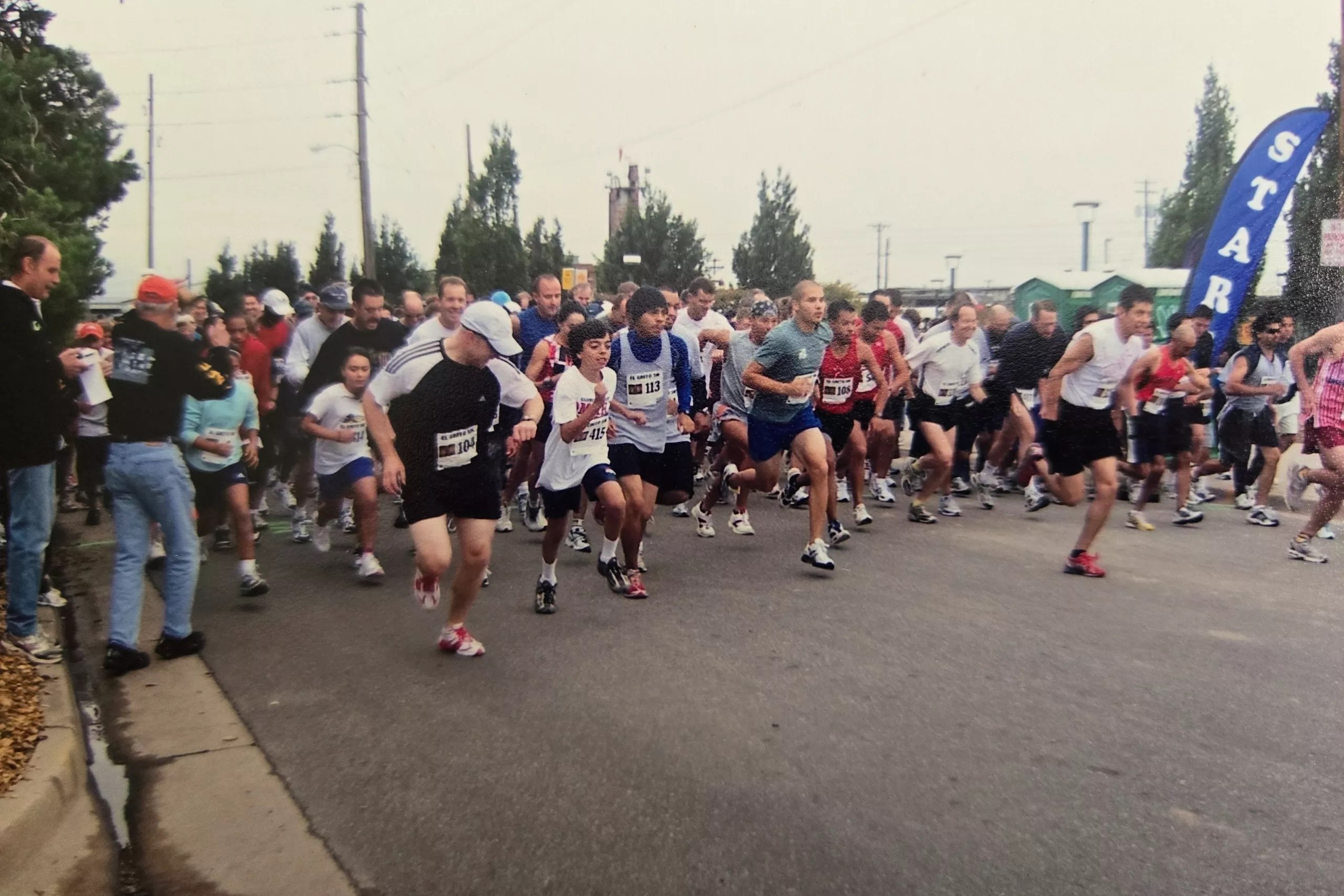

Audio By Carbonatix
Denver’s El Grito 5K race celebrating Mexican Independence Day returned on Sunday, September 14, for the first time in five years.
“It’s going to be exciting to have it re-inaugurated,” says Tina Romero, a member of the group that established the race in 1994 and part of the team bringing it back. “It’s like starting anew, starting from scratch.”
The 2025 El Grito 5K took place two days before Mexican Independence Day; while the original course was in the La Alma Lincoln Park neighborhood, it now comprised three loops around the Auraria Campus. Like the original race, though, the money raised will go to scholarships for Denver student runners who want to continue their education.
Denver’s El Grito 5K race took place every year from 1994 to 2019 before COVID-19 interrupted its quarter-century run. It was always a small event, with the largest attendance about 450 runners a few years before the race stopped, Romero says. This year, only about 200 people are expected to run.
This year, make your gift count –
Invest in local news that matters.
Our work is funded by readers like you who make voluntary gifts because they value our work and want to see it continue. Make a contribution today to help us reach our $50,000 goal!
The race was started by a group of educators who met while training for the 1994 Denver International Marathon. As Romero remembers it, the effort was led by Rich Romero (no relation), a Spanish teacher and an “elite runner” who completed nearly two dozen marathons and more than 200 half marathons, according to his 2022 obituary in the Denver Post.
Rich’s granddaughter, Claudia Perez, is working with Romero to organize El Grito’s return. The race, which she walked as a child and ran by the time she was a teenager, was a big part of her life growing up because of how important it was to her grandfather and his wife, Esther.
“They talked about it with a lot of pride,” Perez says. “They had a strong work ethic and were really proud of being something bigger than themselves.”
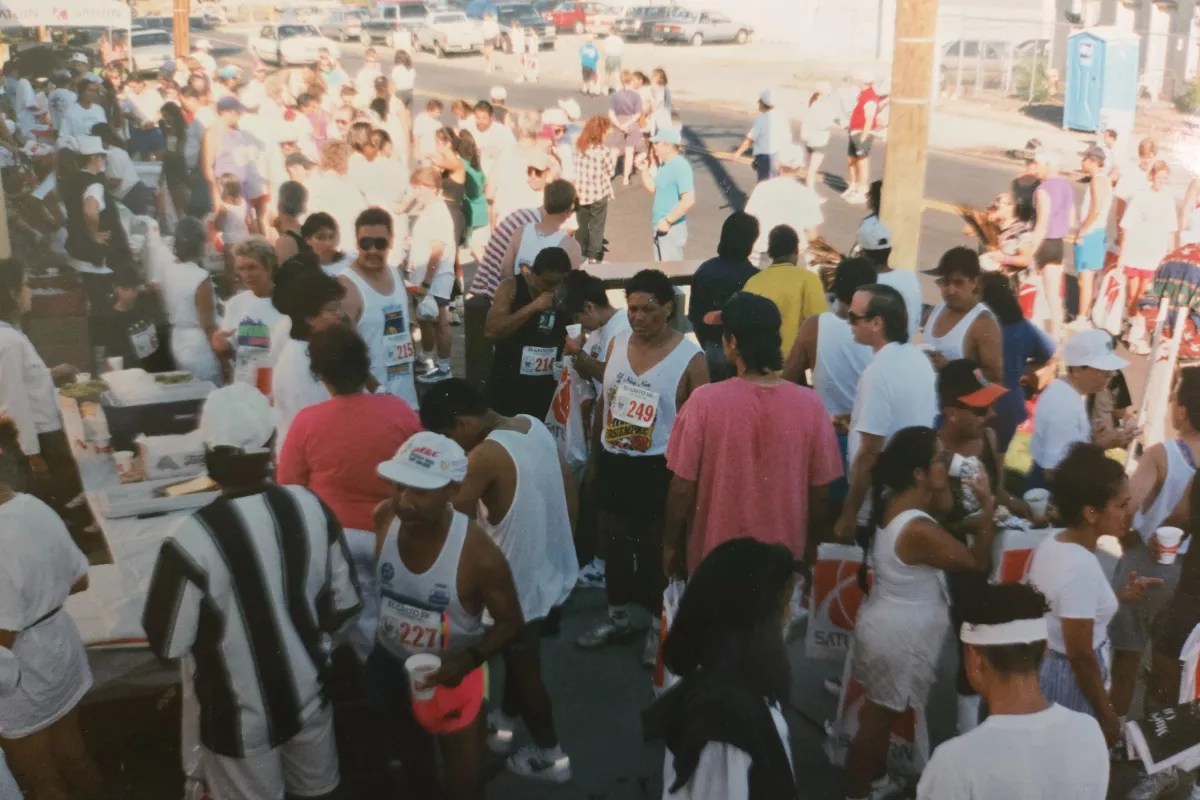
Denver’s El Grito race will continue for the first time in five years. The race started in 1994 in the La Alma neighborhood and will move to Auraria on Sunday, September 14.
Courtesy of Claudia Perez
A Race and Celebration of Mexican Roots, Chicano Values
With the exception of an Irish couple, the people who founded the race were Chicanos looking for a way to recognize Denver’s Chicano heritage and show the community the benefits of running.
The Cinco de Mayo celebration hosted by NEWSED, the New Westside Economic Development community development organization, had already been around for six years by 1994 and the race planners didn’t want to compete, so they looked for another date tied to their Mexican-American identity. September 16 was the obvious choice; it’s the day when Father Miguel Hidalgo, a Catholic priest, called for liberation from Spain in 1810.
Cinco de Mayo, which commemorates Mexico’s victory over the French at the Battle of Puebla in 1862, hasn’t been celebrated widely in Mexico for more than a century. Mexico saves its pageantry and patriotism for September 16, Independence Day.
According to Perez, the mid-September date also appealed to Rich and his wife because it coincided with the kickoff of the Broncos season (they were season ticket-holders for 52 years), the beginning of fall, when he’d see “Colorado roasted chiles up and down the highway,” and the early weeks of the school semester.
“El Grito was recognized as this moment of celebration and cultural identity,” Perez remembers. “And it was just a very festive time of the year.”
The first logo for the El Grito race was tied to Mexico’s identity, too. It depicted two runners from Mexico’s Tarahumara, an indigenous group from northern Mexico known for running long distances in handmade sandals and garbs.
Someone in the organizing group suggested the image after digging up a 1993 Denver Post article featuring two Tarahumara runners racing the Leadville Trail 100-mile ultramarathon. They inspired the El Grito logo, which will return as the symbol of the 2025 race.
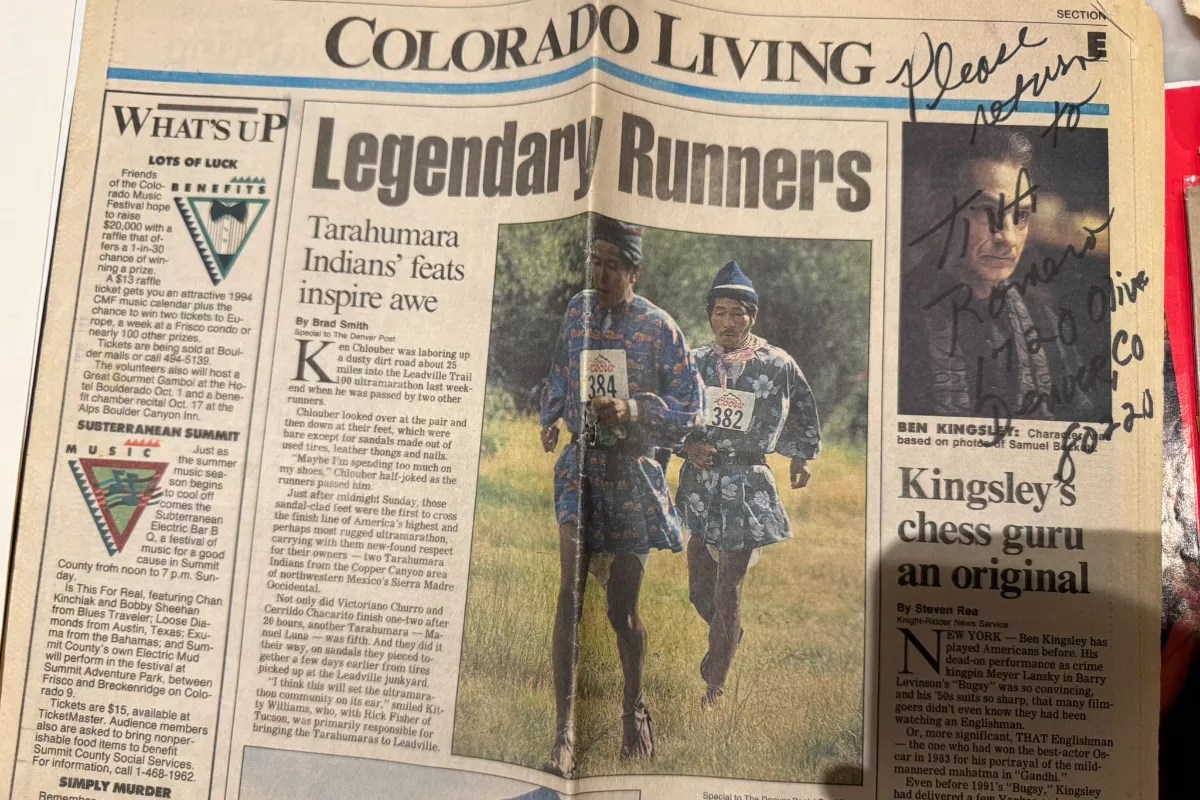
The logo for the first race El Grito came from a republished Denver Post article in 1993 that showed Tarahumara runners at the Leadville Trail 100 ultramarathon.
Courtesy of Tina Romero
NEWSED, Cinco de Mayo and the First Race
NEWSED agreed to help organize the first race. It had been working to channel Chicano activism into a sense of culture and community in west Denver, in particular in the La Alma Lincoln Park neighborhood, since the 1970s.
The NEWSED offices on Santa Fe Drive near West 10th Avenue served as the start and finish line for the inaugural El Grito race in 1994, with most of the race taking place on Santa Fe. However, NEWSED wasn’t able to continue hosting the race, and in early 1995, the agency moved its growing Cinco de Mayo celebration to Civic Center Park from Santa Fe.
Roi Davis, the owner of the Buckhorn Exchange, stepped in to sponsor the race; he moved the start and finish line to the front of his restaurant at 1000 Osage Street. The group leading El Grito saw the race as a chance to promote health and wellness as Chicano values, “not drinking and eating tacos like Cinco de Mayo. We didn’t want that image,” Romero says.
“We value culture, we value our education, we value the benefit of running,” she adds. “Cinco de Mayo, the way it’s perceived in the U.S, it’s just a big party. Yeah, we’re going to have beer at our race, but that’s not going to be the whole impetus for putting this on.”
The 2025 loco for the El Grito race will resurrect the old logo used in the first race in 1994. Courtesy of Tina Romero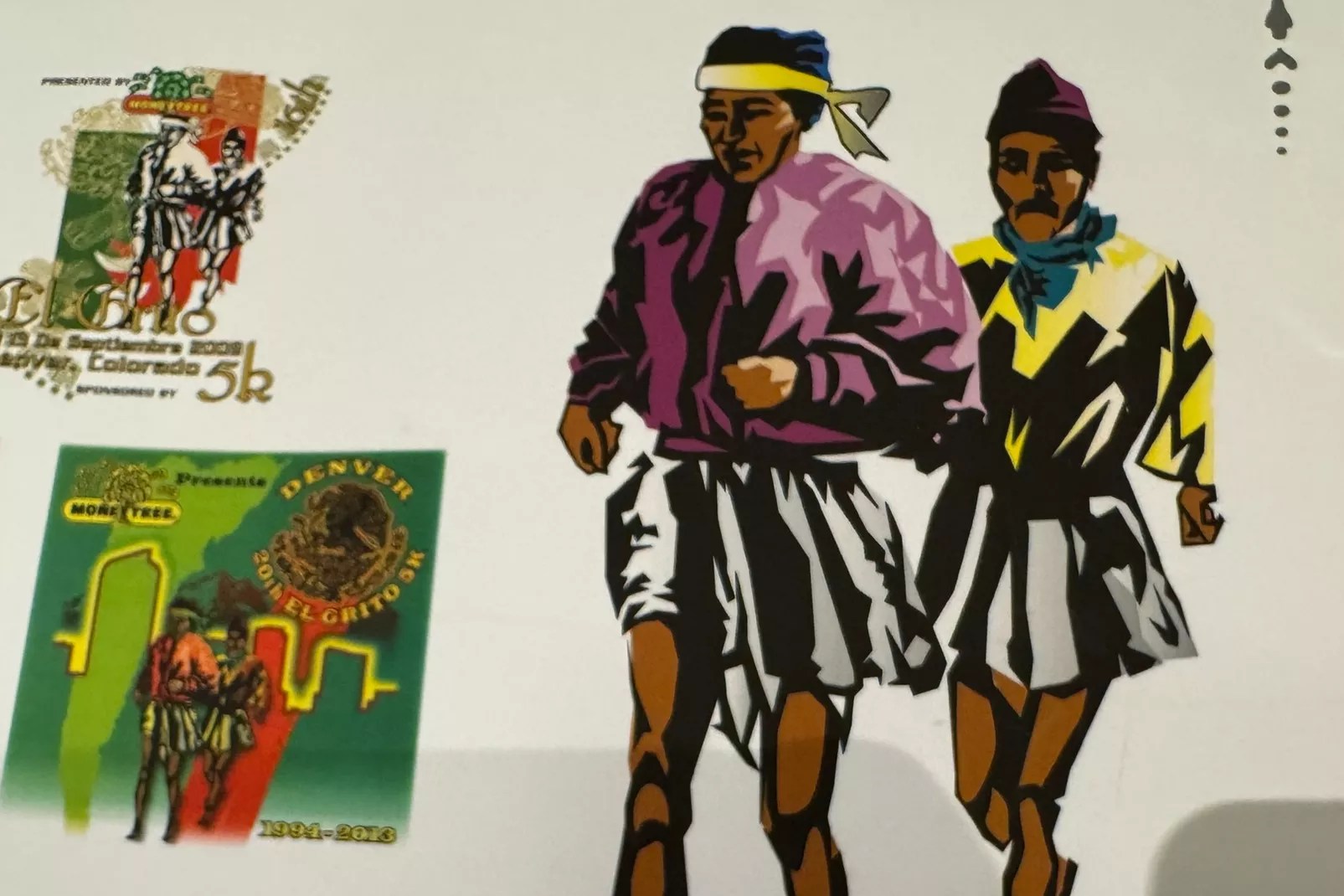
Buckhorn and the Bridge
Before the race, there was a ceremony that included a commemorative bell ringing. In 1810, Hidalgo called for the liberation of Mexico by running to the top of a church tower and ringing a bell to attract the townspeople; that act has since become part of a legend known as El Grito de Dolores (the Cry of Dolores, named after the town where it took place; “Dolores” also means “pain,” giving it a double meaning in Spanish).
Every night on September 15, the President of Mexico goes onto the balcony of the National Palace to give El Grito de Independencia and shout “¡Viva México!” in honor of Father Hidalgo.
Denver’s El Grito carried on that Mexican tradition; it was followed by a rendition of “The Star-Spangled Banner,” which for several years was sung by Rich’s granddaughter (Perez’s cousin). After that, the starting gun was fired, and all the runners took off at the same time.
The course took them north on Osage Street to West 13th Avenue, where they turned right towards Kalamath Street. They then ran six blocks south to West Eighth Avenue, and then right across the bridge over Burnham Yard before turning around and backtracking the whole route.
While passing houses in La Alma, “the neighbors and families in those homes were in their yards or sitting on their front porches and were clapping and cheering when you ran by,” Perez says. “That felt special, because it felt like the neighborhood and the community were a part of the fun.”

After the first race in 1995, the Buckhorn Exchange started hosting the El Grito 5K start and finish line as well as the ceremonies before and after the race.
Courtesy of Claudia Perez
The real fun, though, was running over the West Eighth Avenue bridge. It had “a slow incline” and coming back over “takes a lot out of you. You’re not realizing,” Romero says.
“The bridge was definitely the best part,” Perez adds. “You’re running on the street, you have to build up a bit of stamina to go up the incline. I think for any runner, having a slope downward is a nice energy burst and then you turn.”
The bridge was “the whole challenge of the race,” Romero explains. A water station was always set up on the east side of the bridge because that’s where people were the most exhausted. “That’s what people loved. They loved the challenge of the bridge. That was really the draw,” she adds. “It’s slow and comfortable running over the bridge, and you have the mountains. It was cool because you had the views and then everybody going over the bridge and then struggling to return.”
While running on the bridge, Perez saw the fastest runners coming back towards her after they turned around on the other side, “waving, and you’re cheering them on from behind in the race,” she says.
Once she got to the other end, it was her turn to come back and see the runners who were behind her and the families and children walking the course. “If you have family members or people you know running the race, that’s when you see them,” Perez says. “It was a fun moment for runners to hoot and holler and clap for each other.”
El Grito kept the same traditions and course until that last race in 2019.
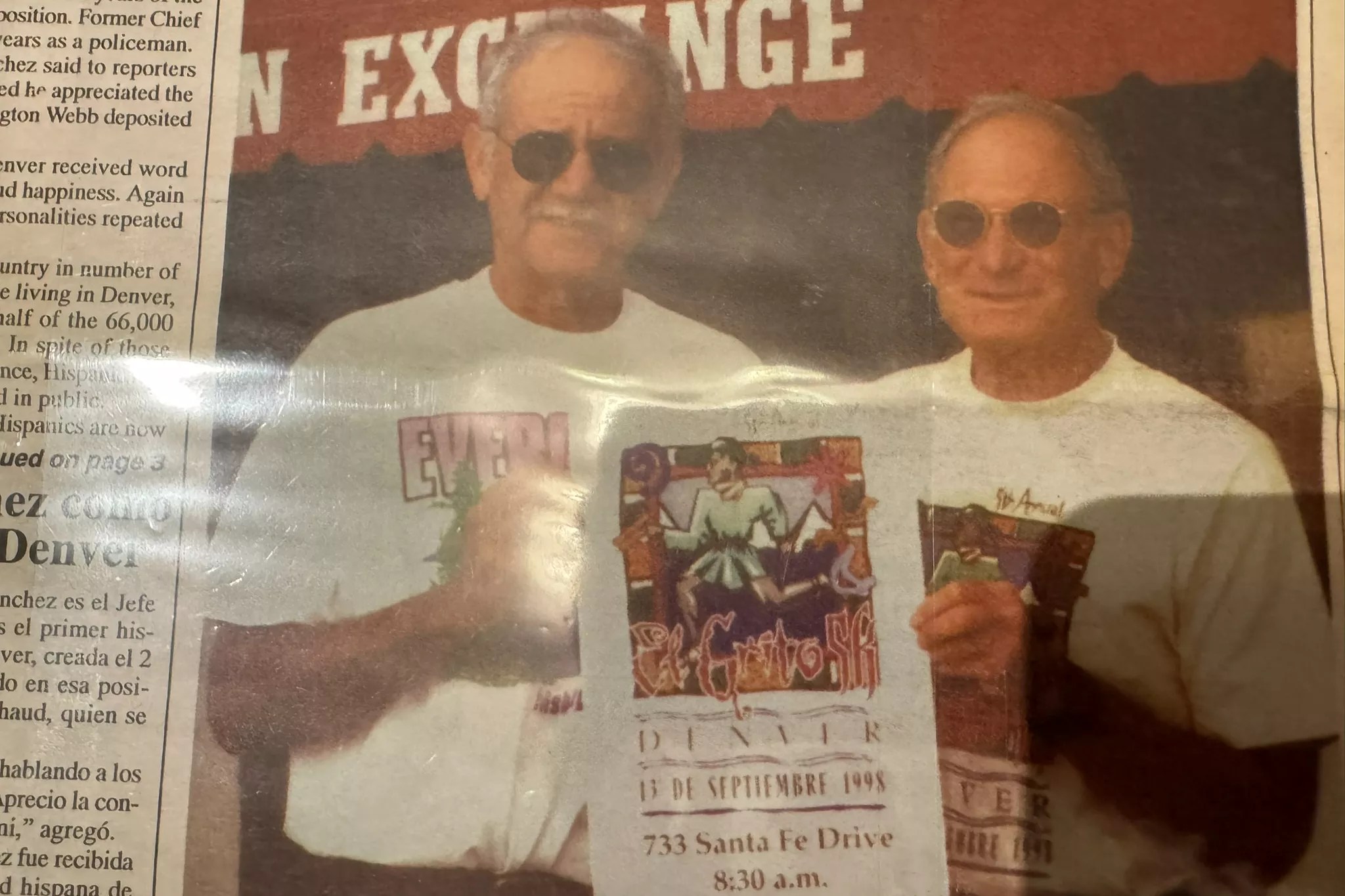
After NEWSED couldn’t continue sponsoring the race, the Buckhorn Exchange owner Roi Davis came and took over and brought the race to his business.
Courtesy of Tina Romero
Bringing It Back
The old route couldn’t be resurrected this year because the cost of a permit and using the Denver Police Department to keep the course clear was too high, Romero says.
She and Perez have been part of the group working since early 2024 to re-launch the race. Romero says she was first approached that April by James Mejia, the chief strategy officer for Metropolitan State University, and Elizabeth Parmelee, the associate vice president for undergraduate studies at MSU. Displaced Aurarians and the La Alma Lincoln Park neighborhood association had a strong interest in seeing the race return, and they’d urged MSU administrators to find a way to bring it back. “They were really motivated and excited to bring the race back,” Romero says. “So that’s how it ended up being on the campus.”
At first, she thought that “I couldn’t do it. I couldn’t bring it back.” But then she recruited Perez to carry on her grandfather’s legacy. Yoli Casas, the executive director of Vive Wellness, also came on to be race director. Casas and her organization were key in helping Denver house and support 43,000 migrants, mostly from Venezuela, who came to Denver over the last two years.
Perez says she feels like she’s bringing the race back at a time when “folks are withdrawing from public spaces and being more cautious about the racial and cultural identities that they hold.” She wants the race to continue as a tribute to Latino immigrants and the history of Mexico and Denver’s Chicanos.
“The fact that El Grito has existed for thirty years and that it’s coming back this year is significant for being able to have a visible and loud celebration for Latino voices and the important roles that Latino immigrants hold,” Perez adds. “To read about your history is one thing, but to see it continue and be celebrated in a living, breathing way is another thing and always felt special.”